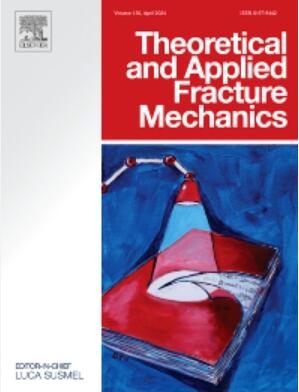A direct crack sizing approach from DIC strain analyses under elasto-plastic and dynamic conditions
IF 5
2区 工程技术
Q1 ENGINEERING, MECHANICAL
引用次数: 0
Abstract
This paper proposes a novel approach to quantify the crack size from strain fields measured from digital image correlation (DIC), by extrapolating the positions at peak strain or peak strain increments identified along paths parallel to the crack plane. The proposed approach does not require data in the immediate vicinity of the crack tip, where DIC measurement is usually less accurate. This study utilizes the modified boundary layer model to demonstrate the strain pattern underpinning the crack size from HRR theory and the single edge notched bend model to verify the crack sizing accuracy from the strain fields. The experimental study further validates the proposed method in plane-sided and side-grooved specimens and evaluates the plastic wake effects on the crack-sizing accuracy for propagating cracks under elasto-plastic conditions. The proposed method identifies the crack tip location directly without measuring the elastic compliance, which enables fast and convenient crack sizing under challenging conditions such as the impact tests. This study demonstrates enhanced fracture resistance of the S550 material under increasing loading rates using the proposed crack sizing method.
求助全文
约1分钟内获得全文
求助全文
来源期刊

Theoretical and Applied Fracture Mechanics
工程技术-工程:机械
CiteScore
8.40
自引率
18.90%
发文量
435
审稿时长
37 days
期刊介绍:
Theoretical and Applied Fracture Mechanics'' aims & scopes have been re-designed to cover both the theoretical, applied, and numerical aspects associated with those cracking related phenomena taking place, at a micro-, meso-, and macroscopic level, in materials/components/structures of any kind.
The journal aims to cover the cracking/mechanical behaviour of materials/components/structures in those situations involving both time-independent and time-dependent system of external forces/moments (such as, for instance, quasi-static, impulsive, impact, blasting, creep, contact, and fatigue loading). Since, under the above circumstances, the mechanical behaviour of cracked materials/components/structures is also affected by the environmental conditions, the journal would consider also those theoretical/experimental research works investigating the effect of external variables such as, for instance, the effect of corrosive environments as well as of high/low-temperature.
 求助内容:
求助内容: 应助结果提醒方式:
应助结果提醒方式:


